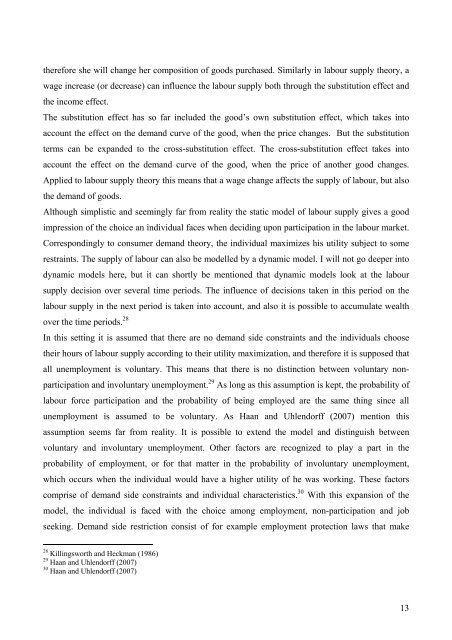An Analysis on Danish Micro Data - School of Economics and ...
An Analysis on Danish Micro Data - School of Economics and ...
An Analysis on Danish Micro Data - School of Economics and ...
You also want an ePaper? Increase the reach of your titles
YUMPU automatically turns print PDFs into web optimized ePapers that Google loves.
therefore she will change her compositi<strong>on</strong> <strong>of</strong> goods purchased. Similarly in labour supply theory, a<br />
wage increase (or decrease) can influence the labour supply both through the substituti<strong>on</strong> effect <strong>and</strong><br />
the income effect.<br />
The substituti<strong>on</strong> effect has so far included the good’s own substituti<strong>on</strong> effect, which takes into<br />
account the effect <strong>on</strong> the dem<strong>and</strong> curve <strong>of</strong> the good, when the price changes. But the substituti<strong>on</strong><br />
terms can be exp<strong>and</strong>ed to the cross-substituti<strong>on</strong> effect. The cross-substituti<strong>on</strong> effect takes into<br />
account the effect <strong>on</strong> the dem<strong>and</strong> curve <strong>of</strong> the good, when the price <strong>of</strong> another good changes.<br />
Applied to labour supply theory this means that a wage change affects the supply <strong>of</strong> labour, but also<br />
the dem<strong>and</strong> <strong>of</strong> goods.<br />
Although simplistic <strong>and</strong> seemingly far from reality the static model <strong>of</strong> labour supply gives a good<br />
impressi<strong>on</strong> <strong>of</strong> the choice an individual faces when deciding up<strong>on</strong> participati<strong>on</strong> in the labour market.<br />
Corresp<strong>on</strong>dingly to c<strong>on</strong>sumer dem<strong>and</strong> theory, the individual maximizes his utility subject to some<br />
restraints. The supply <strong>of</strong> labour can also be modelled by a dynamic model. I will not go deeper into<br />
dynamic models here, but it can shortly be menti<strong>on</strong>ed that dynamic models look at the labour<br />
supply decisi<strong>on</strong> over several time periods. The influence <strong>of</strong> decisi<strong>on</strong>s taken in this period <strong>on</strong> the<br />
labour supply in the next period is taken into account, <strong>and</strong> also it is possible to accumulate wealth<br />
over the time periods. 28<br />
In this setting it is assumed that there are no dem<strong>and</strong> side c<strong>on</strong>straints <strong>and</strong> the individuals choose<br />
their hours <strong>of</strong> labour supply according to their utility maximizati<strong>on</strong>, <strong>and</strong> therefore it is supposed that<br />
all unemployment is voluntary. This means that there is no distincti<strong>on</strong> between voluntary n<strong>on</strong>participati<strong>on</strong><br />
<strong>and</strong> involuntary unemployment. 29 As l<strong>on</strong>g as this assumpti<strong>on</strong> is kept, the probability <strong>of</strong><br />
labour force participati<strong>on</strong> <strong>and</strong> the probability <strong>of</strong> being employed are the same thing since all<br />
unemployment is assumed to be voluntary. As Haan <strong>and</strong> Uhlendorff (2007) menti<strong>on</strong> this<br />
assumpti<strong>on</strong> seems far from reality. It is possible to extend the model <strong>and</strong> distinguish between<br />
voluntary <strong>and</strong> involuntary unemployment. Other factors are recognized to play a part in the<br />
probability <strong>of</strong> employment, or for that matter in the probability <strong>of</strong> involuntary unemployment,<br />
which occurs when the individual would have a higher utility <strong>of</strong> he was working. These factors<br />
comprise <strong>of</strong> dem<strong>and</strong> side c<strong>on</strong>straints <strong>and</strong> individual characteristics. 30 With this expansi<strong>on</strong> <strong>of</strong> the<br />
model, the individual is faced with the choice am<strong>on</strong>g employment, n<strong>on</strong>-participati<strong>on</strong> <strong>and</strong> job<br />
seeking. Dem<strong>and</strong> side restricti<strong>on</strong> c<strong>on</strong>sist <strong>of</strong> for example employment protecti<strong>on</strong> laws that make<br />
28 Killingsworth <strong>and</strong> Heckman (1986)<br />
29 Haan <strong>and</strong> Uhlendorff (2007)<br />
30 Haan <strong>and</strong> Uhlendorff (2007)<br />
13
















